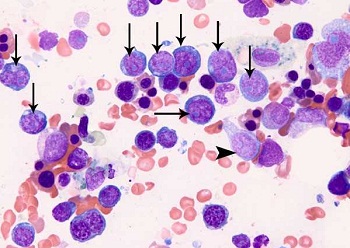The inside of your long bones contain bone marrow, which is a soft tissue mass where young blood cells (blast cells) are formed. A sudden (acute) abnormal growth of white blood cells in the bone marrow can result in a certain type of cancer called AML or acute myeloid leukemia. This disease can have an aggressive course and immediate treatment must be sought.
What Is Acute Myeloid Leukemia?
AML begins in the inner core of the long bones or bone marrow. In this condition, the bone marrow or blast cells do not mature as expected and they remain as immature cells, which keep growing in number. Doctors also refer to AML as acute myelogenous leukemia or acute myelocytic leukemia. Other names include acute non-lymphocytic or acute granulocytic leukemia.
AML tends to have an aggressive course and can quickly become fatal without proper treatment. Leukemia can quickly spread to your blood and other organs such as:
- Lymph nodes

- Spleen
- Liver
- Brain
- Spinal cord
- Testes
What Are Symptoms of Acute Myeloid Leukemia?
The signs and symptoms of AML are often vague and can mimic other conditions. These include:
- Fever
- Fatigue
- Night sweats
- Loss of appetite/weight
Symptoms of acute myeloid leukemia are often the result of a marked decline in normal blood cells. Leukemic or blast cells crowd out the red blood cells (RBCs) in your bone marrow, resulting in:
- Fatigue
- Weakness
- Headaches
- Dizziness
- Light-headedness
- Feeling cold
- Shortness of breath
A decline in normal white blood cells (WBCs) usually results in:
- Fevers
- Recurring infections
A decline in blood platelets may lead to symptoms like:
- Unexplained bruising
- Frequent/severe nosebleeds
- Bleeding gums
- Other unusual bleeding
Leukemia cells may also affect other organs and cause other symptoms such as:
- Bone pain
- Joint pain
- Liver or spleen enlargement, which causes swollen belly
- Lumps/rashes on the skin
- Swollen, bleeding gums
- Headaches
- Trouble with balance
- Blurred vision
- Vomiting
- Seizures
- Enlarged lymph nodes
Main Causes of Acute Myeloid Leukemia
AML is caused by a mutation in the DNA of stem cells that eventually develop into red blood cells, white blood cells, and platelets. This DNA mutation causes an abnormal production of immature white blood cells. Unlike the normal white blood cells, these immature blast cells do not have the capability to fight infection. As their numbers increase, the number of healthy platelets and red blood cells fall, causing many symptoms characteristic of chronic leukemia.
The exact cause of the genetic mutation in acute myeloid leukemia is not known, but some factors can increase your risk of developing the disease. These risk factors include:
- Exposure to radiation
- Smoking
- Genetic disorders
- Blood disorders
- Benzene and other toxins
How to Treat Acute Myeloid Leukemia
The treatment of acute myeloid leukemia involves using chemotherapy or medicines that kill cancer cells. This may include more than one type of drug.
Chemotherapy, however, can also harm normal cells and cause side effects like:
- Increased bleeding tendency
- Frequent infections
- Weight loss
- Mouth sores
Supportive treatments for acute myeloid leukemia include:
- Antibiotics to treat infections
- Transfusion of red blood cells to treat anemia
- Transfusion of platelets to control internal bleeding
A bone marrow transplant is usually done after one or two rounds of chemotherapy. The decision to transplant bone marrow containing stem cells depends on several factors, such as:
- Your age
- Overall health
- Your white blood cell count
- Genetic changes in the leukemia cells
- Availability of donors
A Word About Prognosis of Acute Myeloid Leukemia
You are considered to be in remission when your bone marrow biopsy shows no evidence of acute myeloid leukemia. Complete remission does not mean you are cured, but your symptoms may improve. This occurs in many patients, depending on their overall health and the genetic changes in the AML cells.
More treatments may be needed in the form of chemotherapy or bone marrow transplants. Younger patients with acute myeloid leukemia usually do better with treatment compare to those who develop AML at an older age. Older adults have a lower 5-year survival rate than younger individuals. Experts believe this may be due to younger people being better able to tolerate chemotherapy. Furthermore, leukemia tends to be more resistant to treatment in older patients.
You are considered to be likely cured of acute myeloid leukemia if cancer cells do not come back within five years of diagnosis.